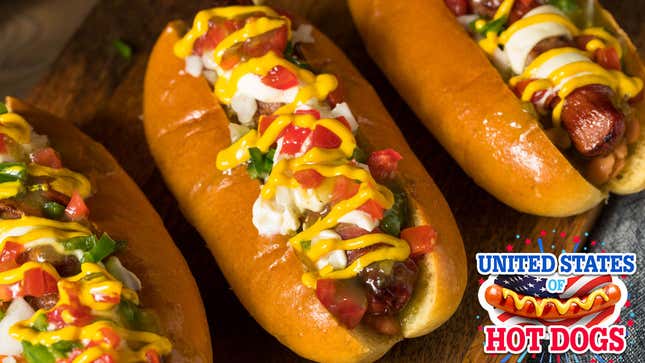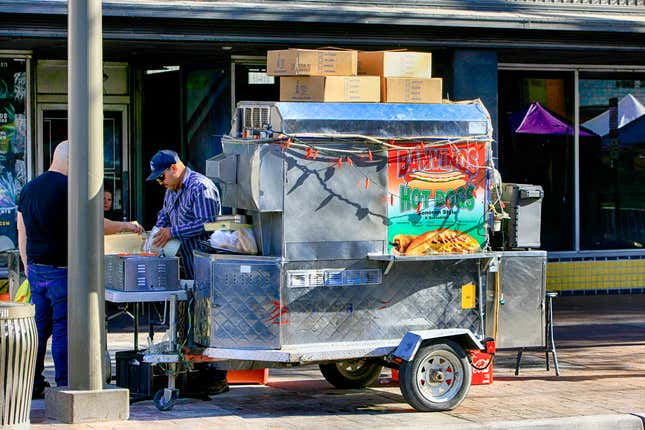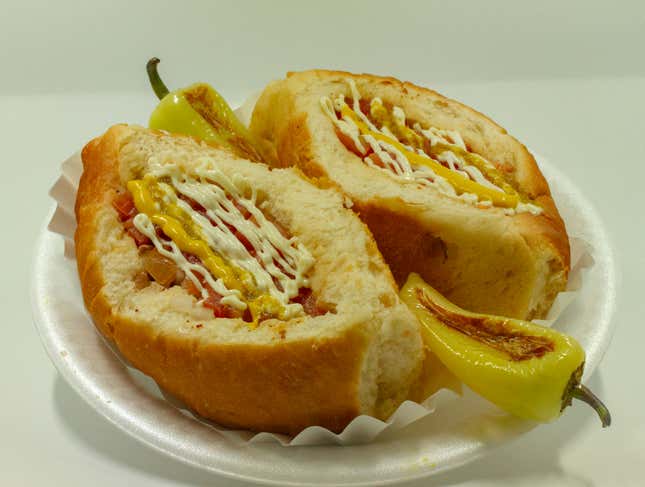
Rafael Krouses handed me a heaving technicolor mess in a bun. We were in a gas station parking lot in Green Valley, Arizona, near the Santa Rita mountains, 40 miles from the Mexican border, amid barrel cacti and agave. But the colorful street food in my hand was the true indication of our location: this was Sonoran hot dog territory.
Like most Sonoran hot dogs, mine looked just like a taco truck had collided with a hot dog cart. It was a mashup of American and Mexican flavors: a bacon-wrapped sausage tucked into a canoe-shaped bolillo roll and smothered in pinto beans, grilled and raw onions, tomatoes, mayonnaise, green salsa, guacamole, canned mushrooms, and a confetti of mixed cheese. For a lady who marvels at regional hot dogs and also sprints toward any taco truck, this was a one-stop miracle. I had everything I ever needed, save for an ability to unhinge my jaw.
Tucson, half an hour away, is full of signs advertising Sonoran hot dogs served from food trucks, in restaurants, in parking lots. This is more than a local interpretation of American snack food: it’s a hallowed meat-and-condiment entity within itself.
Let’s start with the bacon-enrobed frank. It’s cooked on a flat-top so the fat gently renders and crips, sealing the bacon to the sausage. The steamed bolillo-style roll—a sweeter, milk-based bun special to Mexican bakeries—provides a practically Tempur-Pedic resting place. “The steamed bun along with a bacon-wrapped frank with all the toppings create the deliciousness of a quick eat,” said Krouses, who’s owned A&S Sonoran Grill since 2009. The Sonoran hot dog is a staple around Phoenix and especially Tucson, and Krouses is one of hundreds of dogueros who prepare the desert delicacy.

With each doguero comes a new panoply of condiments. There are some you see everywhere: pinto beans (sometimes cooked with bits of chorizo), onions (grilled, raw, or a combo), chopped tomatoes, or pico de gallo. The dogs are finished with streaks of what’s usually mayonnaise, or a mayo-crema blend, sometimes zapped with lime. Another staple is a grilled guero pepper, chartreuse and blistered from the grill, sometimes cooked in leftover bacon fat. Then there’s room for interpretation. While Krouses’ dog had guac, some dogueros use avocado puree, salsa verde, mustard, ketchup, and cotija cheese. Other spots offer pickled veggies, nacho cheese, or potato chips. If this sounds like too much, there are plenty of people in Southern Arizona who will convince you otherwise.
“All the flavors come together with the combination of spicy, creamy, fatty, salty,” said Christina Barrueta, an author and culinary journalist based near Phoenix. “To me, it’s probably the quintessential Mexican border food, to show the cross-cultural meld of the American hot dog with the Mexican fixings. It came over the border with the hot dog and it went back over after its transformation with the bolillo and the bacon and all the toppings.” She notes that there are Sonoran hot dog spots outside of Arizona and Sonora—in Los Angeles, for instance—but it somehow hasn’t spread across the country in the way of, say, the chimichanga. Bite Magazine aptly called it “perhaps one of the most known/not-known regional culinary icons.” Barrueta said, “You’ll find a group of people, me included, who say I would love the Sonoran dog to be the [Arizona] state food. I think it’s more representative.” (The closest thing Arizona has to a state food is its state fish, the Apache trout.)
Diversity has always been part of Sonoran history. As Sonora-born chef Minerva Orduño Rincón told me, the state of Sonora itself, which borders the U.S., has long been a melting pot of Asian and European immigrants. “In my cooking and my teaching about Sonoran culture that’s something that I always touch upon,” she said. Sonora is also known for its beef industry and baseball—solid pillars to serious hot dog fandom, indeed. Orduño Rincón described a “symbiotic relationship” between the two sides of the border in creating the Sonoran hot dog.
The history of the Sonoran hot dog goes back to around the middle of the 20th century. Legends say it originated at late-night food carts around the University of Sonora in Hermosillo, the state capital. “It should technically be called the Hermosillo dog,” Orduño Rincón said. Within Sonora, there are endless variations. One article notes nine types in the city of Obregón alone, from one with chili verde to a shrimp-filled hot dog to one so stuffed with condiments that it’s called “the pregnant one.”
Since it was adopted by hungry college students, it’s become a Southwest American staple. A 2015 report cited more than 200 vendors spanning food trucks and restaurants in Tucson alone. Tucson emerged as the stronger hot dog capital, likely due to more stringent food truck regulations in Phoenix, which put restrictions on toppings and bacon grilling. Tucson dogueros are able to offer freshly made condiments and cook the bacon and hot dog together.

Perhaps the best known Sonoran hot dog pioneer is Daniel Contreras, Sonora-born founder of El Güero Canelo. It began as a food truck in October 1993 on Tucson’s 12th Avenue and now has three restaurant locations and a meat market. In 2018 it won a James Beard America’s Classics award.
“The condiments are what make it a Sonoran hot dog,” Contreras wrote me in an email. Contreras’ own Sonoran hot dog has a much-coveted jalapeño sauce. “I would say it is authentic and a unique food that embodies the culture of border living, which is possibly why Southern Arizona has taken to it.” People eat it on all occasions. I had my first for breakfast, but it’s a go-to late-night snack, especially in Sonora. It’s also, Contreras added, a great way “to cure that gnarly hangover.” Its symbolism seems to ring true even for him. “It is a fusion of different cultures and people! You could call it a melting pot in a bun, jajaja.”
Barrueta predicted that in 10 years, more people around the U.S. would know the Sonoran hot dog. It’s surprising it isn’t more ubiquitous, especially considering the bacon wrap. But until then, it’s worth a trip to the desert.